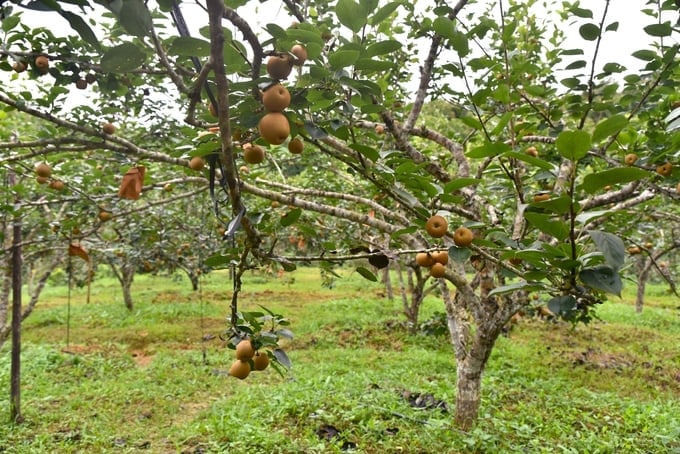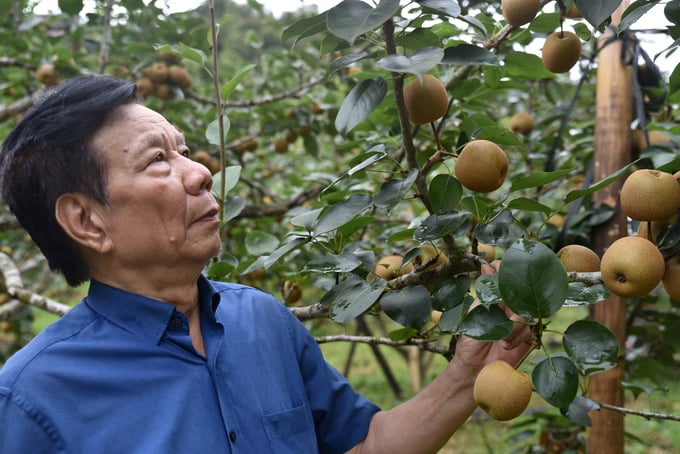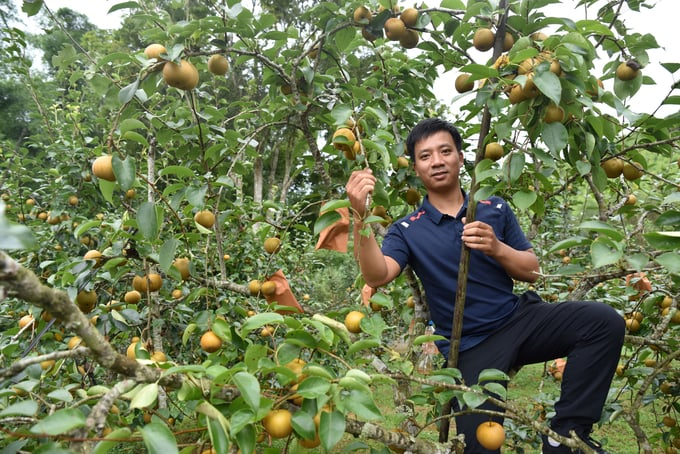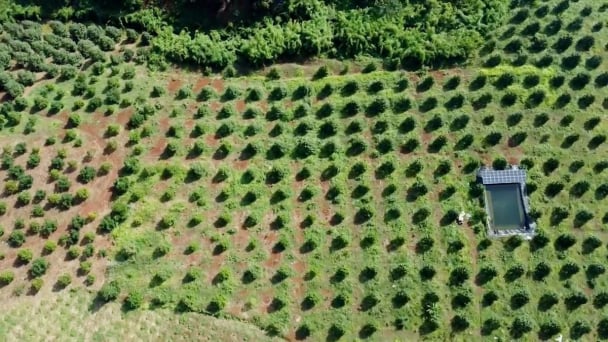May 31, 2025 | 14:37 GMT +7
May 31, 2025 | 14:37 GMT +7
Hotline: 0913.378.918
May 31, 2025 | 14:37 GMT +7
Hotline: 0913.378.918

Pear garden imported from Taiwan planted in Trang Dinh, Lang Son. Photo: Duong Dinh Tuong.
The "goods" were the grafted branches of three temperate fruit tree varieties: peach, pear, and persimmon. These were sent according to the protocol on exchanging fruit tree genetic resources signed between Taiwan, represented by the Taiwan Agricultural Research Institute (TARI), and Vietnam, represented by the Vietnam Academy of Agricultural Sciences (VAAS). Professor Dr. Vu Manh Hai was the chairperson overseeing the content of this protocol.
Upon arrival at Noi Bai Airport, it was observed that many of the branches appeared to have rotted or turned black at the base due to prolonged storage and transport in warehouses and on the plane. Despite this setback, the team remained undeterred. Later, the Taiwanese side informed us that the shipment encountered some procedural issues and had to be rerouted through several other countries before reaching Vietnam.

Prof. Dr. Vu Manh Hai next to a pear tree imported from Taiwan. Photo: Duong Dinh Tuong.
Upon receiving the 'goods ', an urgent meeting of the working group, comprising researchers from the Vietnam Academy of Agricultural Sciences, the Institute of Vegetable and Fruit Research, the Plant Protection Institute, and the Sa Pa Temperate Tree Research Center, was convened. Their dedication was evident as they reviewed and inspected the materials, and discussed an appropriate implementation plan.
Professor Dr. Vu Manh Hai explained, "Because the shipment had to take a long detour, and some parts were wilted and feared to lose vitality, we quickly transported the grafted branches to the nearest locations with available rootstocks. These locations were planned for experimental planting in three main directions: Son La, Lao Cai (including the Ha Giang area), and Lang Son. The goal was to 'put eggs in multiple baskets' to avoid the risk of losing all the varieties.
The experimental planting sites, representing the sub-regions of the northern mountainous region capable of developing temperate fruit trees, achieved significant results, contributing to confirming the adaptability of the imported varieties to local ecological conditions, especially pears, which are considered a top priority in developing temperate fruit trees in the northern mountainous region.

Close-up of a Taiwanese pear variety. Photo: Duong Dinh Tuong.
"Among the six pear varieties, I found Mi Xue to ripen the earliest, with the best quality and thick skin suitable for long-distance transport. The Heng Shan variety also shows great potential with large fruits, thick skin, and fairly good quality. A pear orchard at the Pho Bang Plant and Animal Seed Center in Ha Giang covers only about 5,000 square meters. However, using a steel frame trellis to create a canopy frame through the branch fastening technique generates tens of millions of dong annually. There is also a farmer's pear orchard in the Trang Dinh district, Lang Son province, where branch fastening with wire has resulted in many beautiful fruits. 2024 marks the end of the five-year project' Development of some advantageous temperate fruit trees in the northern mountainous region' by the Vietnam Academy of Agricultural Sciences. After obtaining variety protection, we plan to expand the production of these varieties."
According to Mr. Hai, temperate fruit trees were imported into Vietnam from various sources, initially from France. Mr. Nguyen Cong Tan showed great interest in temperate fruit trees from France when he was the Minister of Agriculture and Rural Development. During his time as Deputy Prime Minister, around 2003 - 2004, France had a cooperation program with Lao Cai province. It established demonstration gardens with many valuable temperate fruit tree varieties in Ta Phin in Sa Pa and the Temperate Fruit and Vegetable Farm in Bac Ha.
"France and Australia have shown great interest in planting temperate fruit trees in Vietnam and have good relations with us. They introduced various types of peaches, apricots, plums, and persimmons to Vietnam. After a period of experimentation, apart from a few varieties with low chilling unit (CU) requirements that could bloom under Vietnamese conditions, such as the Maraviha and Missour peach varieties, many temperate fruit tree varieties from France were not very suitable because they originated from places with much colder climates.

Currently, many farmers in the northern mountainous provinces have successfully grown and earned high income with pear varieties imported from Taiwan. Photo: Duong Dinh Tuong.
Meanwhile, the varieties imported from Australia, mainly through cooperation within the ACIAR project framework, had a higher success rate. Peach varieties such as Tropicbeauty and the nectarine Sunwright and plum varieties like October Blood, Gulfgold, and Rubenal were able to flower and bear fruit well in some experimental planting locations and were accepted by local people, though the area under cultivation remains modest," said Mr. Hai.
Mr. Hai recalled: "Mr. Nguyen Cong Tan always worked with the spirit of putting the nation first. He often traveled abroad and, being passionate about agriculture, would bring back good varieties as souvenirs. Furthermore, he was proactive in finding ways to introduce new varieties, not just plants and animals but also new techniques. Once, after returning from Italy, he told Professor Tran The Tuc, who was then the Director of the Institute of Vegetable and Fruit Research, and me to go immediately to Sicily to see how the Italians grow oranges and tangerines on rocky mountains."
We saw a vast area of oranges and tangerines planted on gently sloping rocky mountains, of course, the type of rock in the process of weathering. Trees were growing well and bearing attractive fruit. When Mr. Phan Van Khai was Prime Minister, during a visit to the Institute of Vegetable and Fruit Research, he told the scientific staff that Mr. Tan was diligent in bringing new things back from abroad.

Garden owner Hoang Van Khi in Doi Can commune (Trang Dinh district, Lang Son province) harvests pears. Photo: Duong Dinh Tuong.
"At our institute, Mr. Tan introduced a series of new varieties, not just temperate fruit trees but also oranges, tangerines, sunflowers for oil, soft-branch tea, and African ornamental palm trees. When introducing new varieties for experimentation, success, and failure are naturally expected as they are imported plants, some suitable and some not. However, regarding his dedication, Mr. Tan excelled at bringing in new varieties. When bringing temperate fruit trees such as peaches and pears to the Temperate Tree Research Center in Sa Pa, he often reminded his assistants to inform our institute to go and inspect immediately. Unfortunately, some trees there no longer exist due to issues with both care and protection.
Moreover, we made several trips to inspect when introducing some orange and tangerine varieties to be planted in an isolated area like Cat Ba Island (Hai Phong). One variety was quite suitable and well-received by the local people, but it has only developed to a limited extent," shared Mr. Hai.
Returning to when Mr. Nguyen Cong Tan was the Minister of Agriculture and Rural Development, Vietnam was focused on ensuring food security and thus concentrated on cultivating staple crops and a few fruit trees like pineapples and oranges. He was always concerned about how Vietnam could export fruits and vegetables worth 1 billion USD (at that time, exports were about 200 to 300 million USD per year, now reaching 6 billion USD per year), with temperate fruit trees contributing a part.
Mr. Hai analyzed that temperate fruit trees are divided into three groups: those requiring high chilling units (many hours of cold) like varieties from China, grown near Beijing with very low temperatures and good quality; those requiring moderate chilling units; and those requiring low chilling units (few hours of cold). In Vietnam, the focus should mainly be on varieties requiring moderate and low chilling units, similar to those from Taiwan or southern China.
Translated by Linh Linh

(VAN) Several scientists and farmers are experimenting with soil treatment in some key durian-growing regions such as Cai Lay (Tien Giang), Dak Song, Gia Nghia, and Dak R’lap (Dak Nong).
/2025/05/25/4127-3-073637_820.jpg)
(VAN) Thanks to the promotion from an FAO-implemented project, vegetable production in greenhouses in Moc Chau has seen strong development, from 1.5 hectares in 2021 to nearly 50 hectares in 2024.

(VAN) FAO has recently supported USD 140,000 to implement the project 'Risk mitigation human-animal interface risks through disease control initiatives in pig farming.'

(VAN) The People's Committee of Tra Vinh province has approved an adjustment to the investment policy for the Green Hydrogen Plant project, increasing its area to approximately 52.76 hectares.
![Reducing emissions from rice fields: [2] Farmers’ commitment to the soil](https://t.ex-cdn.com/nongnghiepmoitruong.vn/608w/files/news/2025/05/05/dsc08881jpg-nongnghiep-140632.jpg)
(VAN) Clean rice cultivation model in Thuong Tan commune, Bac Tan Uyen district, is assisting local residents in achieving sustainable agriculture by substantially reducing costs, increasing productivity, and protecting the environment.

(VAN) At the conference to disseminate Resolution No. 68, AgriS introduced its digital agricultural ecosystem and reaffirmed its commitment to accompanying the Government in promoting private sector development and sustainable agriculture.

(VAN) 'Blue Ocean - Blue Foods' initiative is designed to restore marine ecosystems and establish sustainable livelihoods for local communities by cultivating a minimum of 1,000 hectares of cottonii seaweed in the first three years.